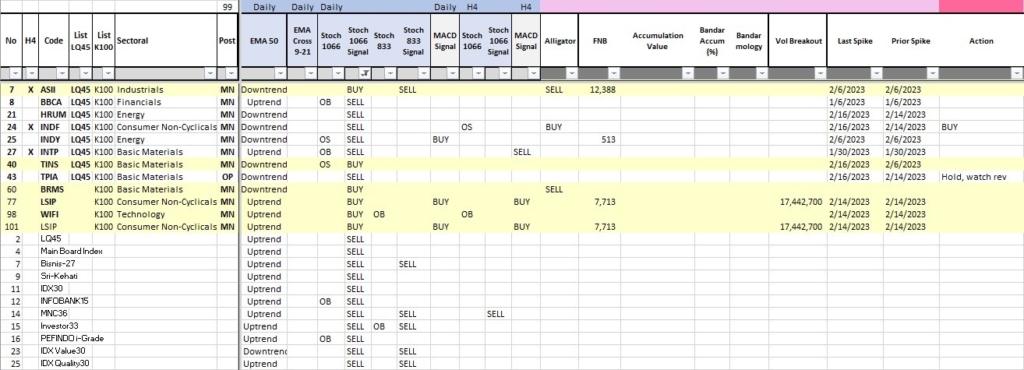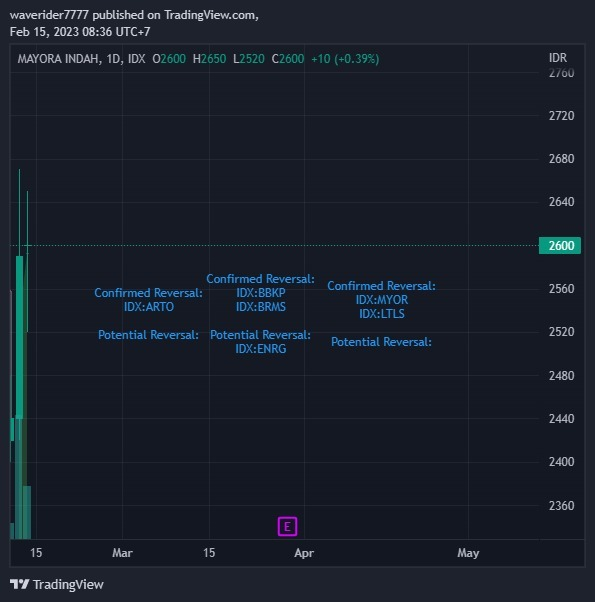Daily Analysis 20230217

February 17th, 2023
Good morning,
Dow closes 400 points lower as hot inflation report, comments from Fed’s Bullard raise rate hike fears
Stocks fell Thursday after another hot inflation report, and a decline in jobless claims, showed the economy is holding up amid the Federal Reserve’s rate hikes.
Dow…….33697 -431.2 -1.26%
Nasdaq.11856 -214.8 -1.78%
S&P 500..4090 -57.2 -1.38%
FTSE…….8013 +14.70 +0.18%
Dax……..15534 +27.3 +0.18%
CAC……..7366 +65.3 +0.89%
Nikkei…..27696 +194.6 +0.71%
HSI………20988 +175.5 +0.84%
Shanghai..3249 -31.5 -0.96%
IDX…..6895.66 -18.87 -0.27%
LQ45….953.49 -4.15 -0.43%
IDX30…495.68 -2.19 -0.44%
IDXEnergy…2098.15 -11.47 -0.54%
IDX BscMat 1260.50 -1.75 -0.14%
IDX Indstrl…1157.69 -0.67 -0.06%
IDXNONCYC..755.41 -4.04 -0.53%
IDX Hlthcare1605.40 -11.73 -0.73%
IDXCYCLIC…849.72 +4.64 +0.55%
IDX Techno5585.84 +57.44 +1.04%
IDX Transp1846.95 +15.38 +0.84%
IDX Infrast….867.03 +7.94 +0.92 %
IDX Finance1423.17 -3.19 -0.22%
IDX Banking1156.81 -8.52 -0.73%
IDX Property….697 -0.30 -0.05%
Indo10Yr.6.7698 -0.0076 -0.11%
ICBI..350.6495 +0.1943 +0.06%
US10Yr.3.8430 +0.0340 +0.89%
VIX……20.17 +1.94 +10.64%‼️
USDIndx104.0500+0.2289+0.21%‼️
Como Indx.270.25 -0.13 -0.05%
(Core Commodity CRB)
BCOMIN…..163.48 +1.63 +1.01%
IndoCDS..105.25 – -%
(5-yr INOCD5) (07/11)
IDR…..15206.50 +39.50 +0.26%
Jisdor.15176.00 -18.00 -0.12%
Euro……1.0690 -0.0045 -0.42%
TLKM….24.87 -0.09 -0.36%
(3774)
EIDO……23.29 -0.11 -0.47%
EEM……40.12 +0.01 +0.02%
Oil……..78.49 -0.10 -0.13%
Gold 1851.80 +6.50 +0.35%
Timah 26658 -159.00 -0.59%
(Closed 02/15)
Nickel.26647.00 +620.90 +2.38%‼️
(Closed 02/16)
Silver…….21.71 +0.14 +0.64%
Copper..412.15 +10.00 +2.49%
Nturl Gas.2.394 -0.072 -2.92%
Ammonia4406.67 unch +0%
China
(Domestic Price)(02/15)
Coal price.214.00 -5.90 -2.68%
(Feb/Newcastle)
Coal price186.30 -9.70 -4.95%‼️
(Mar/Newcastle)
Coal price183.95 -11.45 -5.86%‼️
(Apr/Newcastle)
Coal price185.45 -11.65 -5.91%‼️
(Mei/Newcastle)
Coal price.137.00 +0.50 +0.37%
(Feb/Rotterdam)
Coal price 139.00-3.00 -2.11%
(Mar/ Rotterdam)
Coal price137.00 -3.00 -2.14%
(Apr/Rotterdam)
Coal price137.40 -1.60 -1.15%
(May/Rotterdam)
CPO(May)….4070 +126 +3.19%‼️
(Source: bursamalaysia.com)
Corn………..675.00 +1.00 +0.15%
SoybeanOil..62.15 +0.71 +1.16%
Wheat…….776.25 -4.00. -0.51%
Wood pulp…6030.00 -20 -0.33%
(Closed 02/16)
©️Phintraco Sekuritas
Broker Code: AT
Desy Era9wati/ DE
Source: Bloomberg, Investing, IBPA, CNBC, Bursa Malaysia
Copyright: Phintraco Sekuritas
US merah rada dalem, europe market closing masih ijo asia varied, IHSG merah lagi
CPO naik tinggi, itu kayanya kemaren AALI LSIP naik tinggi… Oil merah, gas drop, coal drop, metal2 naik semua, watchout for ANTM MDKA INCO
IHSG – 2 hari NFS, belum jadi break resistance, masih SW dulu. stoch down, MACD sell, MFI sw, bd sw, jangan terlalu aggresive dulu, cermati yang lagi hajatan aja. Major trend masih up, wave 3, tapi belum lari. Kayanya nunggu resmi laporan keuangan big bank keluar semua dulu
Tinggal infrastructure yang arahnya bagus, healthcare melemah juga
Stoch Buy Signal: ASII TINS BRMS LSIP WIFI
MACD Buy Signal: GOTO INDY SRTG AALI ASSA LSIP
Alligator Buy Signal: INDF AGII BRMS MLPL IGAR
Supertrend: MTEL AALI LSIP WIFI



















